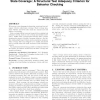Free Online Productivity Tools
i2Speak
i2Symbol
i2OCR
iTex2Img
iWeb2Print
iWeb2Shot
i2Type
iPdf2Split
iPdf2Merge
i2Bopomofo
i2Arabic
i2Style
i2Image
i2PDF
iLatex2Rtf
Sci2ools
SIGSOFT
2007
ACM
2007
ACM
State coverage: a structural test adequacy criterion for behavior checking
We propose a new language-independent, structural test adequacy criterion called state coverage. State coverage measures whether unit-level tests check the outputs and side effects of a program. State coverage differs in several respects from existing test adequacy criteria, such as code coverage and mutation adequacy. Unlike other coverage-based criteria, state coverage measures the extent of checks of program behavior. And unlike existing fault-based criteria such as mutation adequacy, state coverage has been designed to be readily automated and to present users with easily understood test inadequacy reports. An experiment showed strong positive correlations between the number of behavior checks and both state coverage and mutation adequacy. Categories and Subject Descriptors: D.2.5 [Software Engineering]: Testing and Debugging?testing tools; D.2.8 [Software Engineering]:Metrics General Terms: Measurement, Reliability
Mutation Adequacy | SIGSOFT 2007 | Software Engineering | State Coverage Measures | Test Adequacy Criteria |
| Added | 20 Nov 2009 |
| Updated | 20 Nov 2009 |
| Type | Conference |
| Year | 2007 |
| Where | SIGSOFT |
| Authors | Ken Koster, David Kao |
Comments (0)

